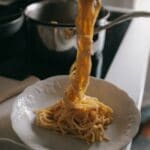Last month, we taught you how to make Pasta alla Zozzona, a combination of Amatriciana, Cacio e Pepe and Carbonara — basically, the best pasta collab ever.
With our Lazio Marketplace event taking place this month, we’re going to spotlight one of the most iconic, classic Italian recipes, Cacio e Pepe. (As I type this, cacio autocorrected to cardio. No, autocorrect. Cacio.)
Cacio e Pepe literally means cheese and pepper in central Italian dialects and is a dish found in Rome, the largest city in the region of Lazio. Traditionally, it is made with Pecorino Romano, cracked black peppercorns and spaghetti or tonnarelli. Although it is one of the simplest Italian dishes out there, it is also one of the trickiest to prepare.
Let’s talk tonnarelli — the traditional pasta for this dish. This long noodle egg pasta is shaped like a square, and is often thicker than the average pasta. What’s nice about it is that it has a rough surface that easily binds to sauces. You can find this pasta, and a ton of other goodies, at Eataly.
The cheese, or cacio, is Pecorino Romano, a cheese that has been in production since 3000 BC.
Pecora literally means sheep in Italian, indicative of the type of milk used for this cheese. Pecorino Romano is known for bursting with character, delivering pungent tones and earthy flavours to the palette. To make the Tuscan version of this dish, you can switch out Pecorino Romano for Pecorino Toscano, a less salty, creamier Pecorino from Tuscany. Locally, Tuscans eat their Cacio e Pepe with mussels.
Remember to always source quality ingredients, looking for products labelled ‘Product of Italy’ or with DOP or IGP certified labels. These geographical indication certifications are a legal guarantee that a product is produced, processed and packaged in a geographical area, following traditional methods. With these labels, you can be sure the food you’re buying is of optimal quality and authenticity.
Great food starts with great ingredients.
Buon appetito!
PrintRECIPE: Cacio e Pepe
Cacio e pepe, the famous pasta dish from Lazio
- Author: ICCO Canada
- Prep Time: 10
- Cook Time: 15 mins
- Total Time: 25 mins
Ingredients
- 350g of spaghetti or tonnarelli
- 250g of Pecorino Romano DOP, grated
- Black peppercorns, to taste
- Fine salt, to taste
- 4 tablespoons of Extra Virgin Olive Oil DOP
Instructions
Grate the Pecorino Romano DOP and set it aside.
Bring water to a boil, using half of what you would usually use to cook pasta. This helps the water be richer in starch.
When the water boils, add the salt and cook the spaghetti or tonnarelli.
In the meantime, crush the black peppercorns in a mortar and pestle to maximize aromatics.
Toast half of the crushed black peppercorns in a non-stick pan on low heat. Then, add some of the pasta water. You should see bubbles appear from the starch in the water.
Cook the spaghetti or tonnarelli to 80 per cent (just before al dente). The pasta should still be a bit undercooked. Drain the pasta and set aside some pasta water to use later.
Add the pasta to the pan with the crushed black peppercorns and some pasta water and continue cooking it in the pan, stirring it continuously to let it breathe. Ladle in more pasta water whenever you see the pan is almost completely dry.
In the meantime, prepare the Pecorino Romano cream. Pour almost half the grated Pecorino Romano into a bowl, keeping some to garnish with later. Add a ladle of pasta water to the bowl. Stir vigorously with a whisk to achieve a cream-like consistency without lumps.
Go back to your pan and finish cooking the pasta to al dente, adding more water if needed. Then, finish with the Pecorino Romano cream. Turn off the heat source to the pan before adding. The key is to whisk it just before it hits the pan, then stir the pasta continuously so the Pecorino Romano cream emulsifies with the rest of the sauce.
Transfer your beautiful Cacio e Pepe into a serving dish and garnish with grated Pecorino Romano and fresh cracked black pepper. Enjoy!
Want to learn more about True Italian Taste? Visit here.



